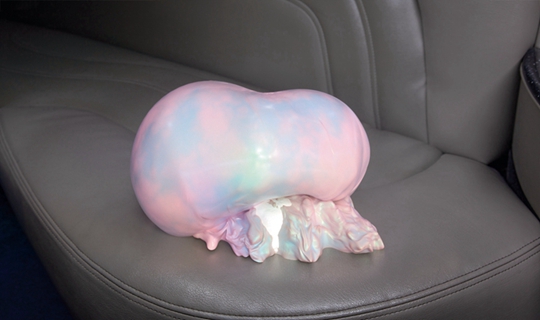BLOBS
| June 23, 2015 | Post In 2015年6月号

I make three-dimensional sculptures and show them in two-dimensional environments. This data can be used for multiple outcomes: videos, still images in unrestricted sizes, 3D printing, and virtual environments. It can mimic reality with physical qualities and simulate complex mathematical forms, which leads to the chosen aesthetic: the failure of virtual reality in the 1990s, the übermensch of Wall Street, the empty and cold success stories of television commercials. The 3D aesthetic was part of my youth, growing up with flying toothpaste, animated Snickers bars, and infomercials selling vaporware. I saw and understood these unrealized fantasies through rendered objects—failed promises and sadness expressed through soothing colors and textures.
You are not bound by physics in these programs. You are given an empty space and you start with a basic form, like a sphere. I let this perfect object react to other objects and forces as if it were drifting through a million years of evolution. Then this perfect form develops an input and output in order to survive, characteristics to surpass other species. A blob is, in a sense, an object that has been through a certain experience or pressure. It represents a simple form of sculpting unbound by gravity, a post-internet way of saying: “Look, here is the simplest modified shape, and I’m using it to make a statement.” I prefer the romantic ontology of an object based on a view of the world.

Object-oriented ontology is based on the idea that all things are objects that interact with one another, and both they and their interactions are real even outside of human perception. To make this point in a virtual world is very compelling: the object exists in binary code and is made visual through a language that makes us believe that it is bound to our laws of physics—while it plainly isn’t. Earlier rendering software was unable to present objects within known physical principles (just watch the 1992 adaptation of Stephen King’s Lawnmower Man). What I can do is highlight the fact that this is what it is: this is our border, pushed towards a virtual reality where the memories of past failure manifest.
After some time wasting energy fighting my background in design, I came to the solution of working with it. It felt like it was time to accept the fact that we consume things, that we always want more, and all that comes with it: short-lifespan fashionable products, minimal production cost with powerful branding, social agreements and deontic powers to accept paper as money or a pair of Gucci flip-flops. We consume more in quantity but, at the same time, settle for lower quality. It fills up empty spaces—the boredom, the loneliness, the existential thoughts—with little glimpses of meaning. I simply changed my tools to those that work for the way we consume, a computer with rendering software instead of a studio with brushes and chainsaws. This reminds me of what Slavoj Žižek says about modern humans avoiding danger: buying milk without fat, beer without alcohol, sex without human interaction. This is where we are, on the verge of a virtual existence. (As told to Milia Xin Bi)

